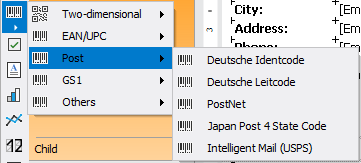Intelligent Mail
IMb (Intelligent Mail barcode), also known as USPS OneCode, is a height-modulated barcode that encodes up to 31 digits of mail sending data in 65 vertical bars, using symbols with 4 states. This symbolism uses four different states of "bars", allowing for encoding more information in a single barcode.

The Intelligent Mail standard was created on the basis of the POSTNET and PLANET standards, which were used in the USA for mail earlier.
These standards allow for the encoding of zip codes and serve mainly for mail sorting and tracking.
POSTNET is able to encode a five-digit postal code, a 4-digit plus code and a 2-digit delivery point code.
POSTNET barcodes have variable lengths ranging from 32 to 62 bars, while PLANET barcodes consist of either 62 or 72 bars. They are modulated in height (vertical columns have different lengths) and have two states (short and long bars). Each digit of encoded data is represented by a group of five bars. In POSTNET barcodes, each group of five bars contains exactly two full bars, while in PLANET barcodes there are three.
IMb technology effectively combines the capabilities of PLANET and POSTNET in one barcode. It allows mail users to use a single barcode to participate in several mail services at the same time, extends the ability of mail users to track individual mail items and provides greater visibility of the mail flow. The use of this barcode allows the Postal Service to provide multiple services to the mailing industry and additional mail tracking features, as well as to track mail performance and reduce costs. Like POSTNET, IMb has a checksum to check the integrity of the code and possible recovery of damaged code.
Compared to POSTNET, IMb has a much larger data capacity (31 characters versus 11). In addition to the routing code, the Intelligent Mail barcode includes four additional fields: barcode identifier, service type identifier (STID), mail program identifier (MID) and serial number. These additional fields allow mail users to define the class of mail, identify the services they want to purchase (e.g., tracking and correcting the address), and allow mail clients to uniquely identify mail items.
The disadvantages include a sufficiently long code and the ability to encode only numbers.
Intelligent Mail allows encoding the following information:
| Information | Description |
|---|---|
| Barcode Identifier (2 characters) | Assigned by the United States Postal Service. |
| Service type identifier (3 characters) | Mail class or other service. |
| Sender ID (6 or 9 characters) | Company ID assigned by the United States Postal Service. |
| Serial number (6 or 9 characters) | The sender is assigned a number to identify a specific recipient or household. |
| Postal code of the delivery point (11 characters) | Not required field. |
Hatches have different height, direction (up, down) and thickness.
Such a barcode can be printed not only on an envelope but also directly on a document. It can then be read through a special transparent window on the envelope.
To generate an Intelligent Mail barcode in FastReport .NET, select the Barcode object ![]() at the Components Panel in the Report Designer. In the drop-down list, navigate to the "Post" category, and then choose Intelligent Mail (USPS):
at the Components Panel in the Report Designer. In the drop-down list, navigate to the "Post" category, and then choose Intelligent Mail (USPS):

After selecting the barcode, place it on the Report Page.
Double-click on the added barcode to open the editor. You can also open the barcode editor by clicking the button  in the context menu of the added object, accessed by right-clicking.
in the context menu of the added object, accessed by right-clicking.
In FastReport, the minimum length of the code is 20 characters. This is because the Postal Code of the delivery point, which is not required, begins with 21 characters.
Changing just one digit completely changes the barcode:
